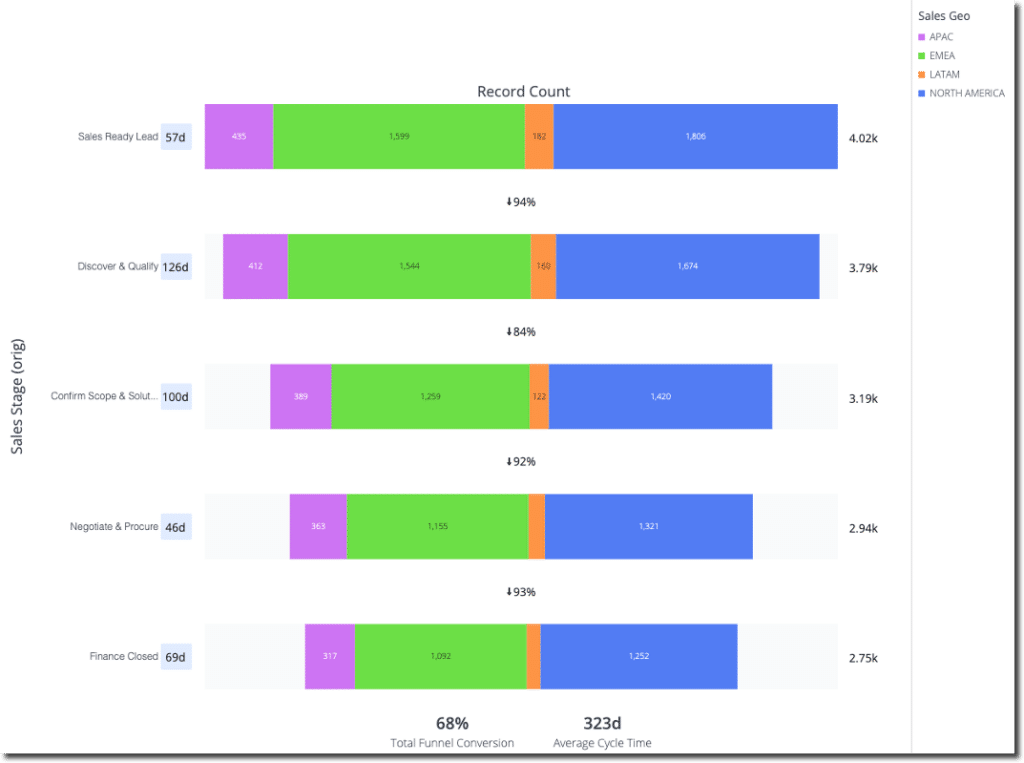Becoming a Sales Leader: Mastering Pipeline KPIs and Leading Your Team to Success
Being an exceptional sales rep doesn’t necessarily guarantee top performance as a sales leader. And to avoid that pitfall, you’ll have to master sales pipeline KPIs and how to use them to lead your team. In this article, we’ll discuss how SugarCRM’s sales automation and measuring capabilities can contribute to a successful journey as a sales leader.
Challenges Faced By Sales Managers
Like all managers, sales managers must find the balance between fostering a positive work environment that encourages growth and development. This requires a well-balanced mix of leadership skills, emotional intelligence, clear communication, and strategic thinking.
At the same time, sales managers face the challenge of managing diverse groups of individuals, each with their own motivations, strengths, and weaknesses. Engaging with various individuals to help them grow professionally while holding them accountable for their results and actions can test your sales manager skills, especially when dealing with underperforming team members. In most scenarios, sales managers must provide extensive coaching and support to help underperforming team members reach their full potential.
Sales managers must also navigate the ever-changing business landscape, adapting their strategies and tactics to keep pace with evolving customer needs, market conditions, and competitive pressures. This requires a high degree of adaptability and a willingness to embrace change, even when it may be uncomfortable or disruptive.
Metrics and KPIs and Why They Matter in Sales Management
Metrics and KPIs give sales managers more context and help sales managers better navigate volatile scenarios. As a sales manager, you create the perfect environment to manage with transparency and accountability when you use and review KPI results.
KPIs serve as the cornerstone for informed and data-backed decision-making, letting sales managers spot trends over time, uncover hidden opportunities, and identify business operations that can be improved. By tracking and analyzing such indicators, sales managers can accurately evaluate their teams’ performance and decide where, when, and how to allocate resources.
As mentioned above, metrics and KPIs also play a determining role in fostering a culture of accountability within your teams. When targets have been fairly and transparently set, and team members know that their performance is being consistently measured against those mutually agreed upon targets, they are more likely to take ownership of their results and work to meet or exceed their goals. In the long run, this creates a more dynamic and motivated sales force, driving better and more consistent results for the organization.
KPIs and metrics also allow sales managers to offer targeted feedback, support, and guidance before performance becomes an issue. This is an advantage for sales managers, as they can create a more supportive work environment where team members’ skills are nurtured to rise to the desired levels.
Simply put, metrics and KPIs are the lifeblood of successful sales team management, providing the necessary tools and insights to drive continuous improvement and exceptional performance.
Sales KPIs You Should Track for Effective Sales Team Management
The KPIs considered essential for tracking sales performance vary depending on the organization, industry, and sales manager. Ultimately, the KPIs must align with the culture and goals of the team and company. SugarCRM offers a wide range of pipeline KPIs that can be customized to meet each customer’s specific needs. This way, customers can choose the most relevant KPIs to monitor and ensure they are aligned with their business objectives.

Here are some key KPIs we believe are essential and that we provide to our customers:
- Forecast versus Quota: This is the most important KPI for all sales managers. This shows sales managers’ day-by-day KPI to illustrate the quota target and how their team forecast and won business is progressing towards it.
- Forecast: Current vs. Prior Quarters: On any day of a sales period, sales managers can look back at the same day in prior periods to review what their forecast looked like at that time, what pipeline they started with, and how they ended up.
- Pipeline: Current and Next Quarter: Sales managers can review if they have enough pipeline to cover their sales targets. For instance, if the blended win rate is 25%, then there will be a 4X pipeline available compared to the remaining target.
- Pipeline Creation Trend: This powerful leading indicator tells you if your marketing and sales teams are sourcing enough new opportunities to feed your pipeline. You want to look for falling pipeline creation trends because your sales targets will suffer a few sales periods.
- Funnel Velocity and Conversion: This KPI measures your team’s ability to move opportunities forward through the sales stages. Measure both stage conversion percentages and days in stage to help spot bottlenecks in your sales process that require your attention. Your goal is to increase conversion percentages and reduce days in-stage.
- Funnel Flow Analysis: Opportunities do not always flow in a nice linear manner, and they do not always exit from the same stage. This KPI will tell you where your sales team takes shortcuts and how far you get in the sales cycle before you lose. Ideally, you want to flow through each step in the sales cycle, and if you are going to lose, you want to lose early.
- Average Deal Size Trend: This KPI shows you the size of your average pipeline opportunity over time. It is often a goal for a growing organization to see the average deal size increase over time.
- Win Rate Trend: Understanding your win rate is crucial to becoming a predictable sales organization and leader. It sets you up to collaborate with marketing about lead generation, and it helps you set team targets for sales prospecting to create a pipeline to support your sales targets. This report shows how your win rate moves over historical sales periods.
- Sales Cycle Trend: This measures the average number of days an opportunity spends in the sales cycle before it is Won, Lost, or closed as Undecided. Sales managers should aim for this indicator to decrease, a sign that the sales process becomes more efficient.
- Sales Velocity by Sales Stage: This KPI shows how your team members are trending over time regarding days spent in each sales cycle. It is useful when coaching team members on how to improve their weaknesses.
- Idle Opportunities Trend: This KPI shows opportunities stuck in a stage for a defined idle time. As a sales leader, it allows you to step in and help them move further down the funnel. Sometimes, salespeople get into situations where they may hesitate to ask for help and would rather ignore the opportunity. As a sales leader, you must ensure that no opportunities are wasted and learn why they may get stuck at some point in their journey.
As a sales manager, you can make more informed decisions and adapt your strategy on the go if you keep a close eye on these metrics and KPIs.
How to Set Realistic and Achievable Sales Targets
Successful sales managers can set realistic goals and push them forward to help their teams evolve. When you set sales targets, make sure to pay attention to the factors below:
- Organization Goals: Your sales teams’ goals must perfectly align with overall organizational goals.
Historical Performance: A company’s historical performance is very likely to give you an insight into future trends of your sales operations unless you are willing to be a disruptive factor. - Market Conditions: Accounting for market conditions is essential when setting sales targets and goals. When setting targets, consider the following: competition, economic conditions, and customer demand.
- Team Resources: when assessing this particular factor, you need to focus on the size and structure of your team, the budget allocated, technology, and if other teams are available to support your efforts.
- Individual Goals: Your department’s base goals should be achievable by 75% of your sales team, and stretch goals should be possible by your top 25% of performers. You should set these goals individually based on each member’s experience and responsibilities.
As a sales manager, you create a clear roadmap to team success when you set realistic and achievable goals.
Utilizing CRM Systems for Sales Metrics Tracking
One of the easiest ways to track your sales metrics and KPIs is inside a CRM. Tools like Sugar offer a centralized platform to track and analyze these. Here are a few key benefits of using CRMs for sales metrics tracking.
- Centralized and Flexible Data Collection: Sugar lets you create workspaces for your sales teams to store their account and opportunity information and compile it with sales data from accounting and ERP systems for accurate measurement.
- Automated and Real-Time Insights: Sugar automatically calculates your KPIs to offer real-time insights and generates spreadsheets and reports based on that data, helping you save time and resources.
- Streamline Sales Processes: storing your KPIs in the same system as your sales processes becomes easier to update procedures on-the-go. Continuous process improvement is the sign of a great sales leader!
How to Use CRMs and KPIs to Coach Your Sales Team
You can leverage KPIs to provide targeted feedback and support your sales team members. This way, sales managers can help to drive continuous improvement and foster a culture of learning and growth.
Make sure to follow the steps below when using KPIs as a coaching tool:
- Set Clear Expectations: you’ll need to create a KPI dictionary to share with your team members. Ensure that each member is aware of how each KPI is calculated and how they can influence it.
- Provide Regular and Consistent Feedback: in individual meetings, make sure to refer to each KPI and that each team member routinely monitors their KPIs.
- Create Action Plans: define and regularly update individual action plans for your team members to empower them to improve KPIs. Ensure to document the action plan together with individual KPIs.
- Track Progress over Time: Seeing the KPIs change over time is empowering to both the sales leader and their team members. Make sure you have the tools to do that. At Sugar, that is the essence of our claim to be the ‘Time Aware’ CRM. We uniquely provide the ability to track your critical KPIs over time.
By using KPIs as a coaching tool, sales managers can become great leaders and help their team members to develop their skills, improve their performance, and achieve their full potential for the organization.
Wrapping It Up
From setting realistic sales targets and fostering a data-driven sales culture to utilizing CRM systems for sales metrics tracking and using KPIs to coach team members, sales managers can employ various strategies to drive exceptional performance and become great sales leaders.
Get in touch with us to discover the real power of a complete CRM in relation to your sales management action plans!
*This blog post was originally published on SugarClub.



